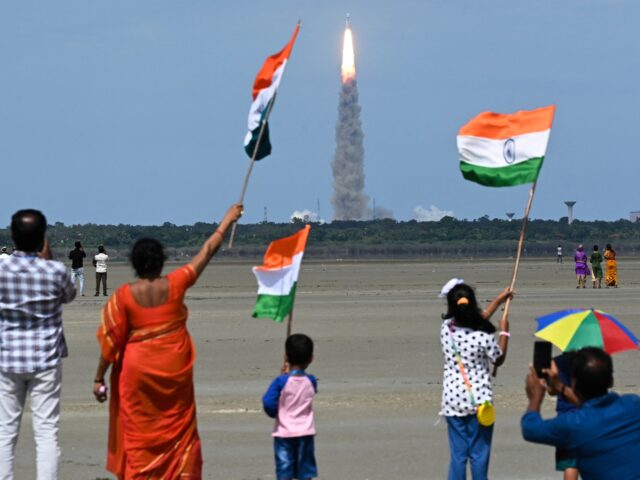The race between India and Russia to make the first landing near the Moon’s south pole took a dramatic turn on Sunday as Russia’s Luna-25 spacecraft tumbled into an uncontrolled orbit and slammed into the lunar surface.
India, meanwhile, announced that its Chandrayaan-3 mission is on schedule for a controlled landing on Wednesday.
Russia’s space agency, Roscosmos, was hoping to win the race to the lunar south pole by landing on Monday. The agency said it lost contact with Luna-25 on Saturday, 47 minutes after a thruster misfired during an orbital adjustment burn. The misfire created an “emergency situation” that Roscomos did not elaborate upon.
“The apparatus moved into an unpredictable orbit and ceased to exist as a result of a collision with the surface of the moon,” Roscomos said.
The Luna-25 mission, launched from Vostochny Cosmodrome on August 10, was Russia’s first moon shot since 1976. The original mission design had the lander carrying a small moon rover, but the rover was ditched to reduce the weight of the lander.
Roscosmos claimed that even with its disastrous conclusion, the mission proved Russia remains “a state capable of delivering a payload to the moon.”

This screen grab made from video footage from ISRO via AFPTV taken on July 14, 2023 shows an Indian Space Research Organisation (ISRO) rocket carrying the Chandrayaan-3 spacecraft lifting off from the Satish Dhawan Space Centre in Sriharikota, an island off the coast of southern Andhra Pradesh state. (ISRO/AFPTV/AFP via Getty Images)
On the other hand, international analysts said the Luna-25 mission was largely intended as a test of landing technology and the calamity occurred during what should have been a relatively safe phase of the lunar approach, so the disaster does not bode well for the state of the Russian space program.
Design or manufacturing defects in the thruster seemed a likely explanation for the crash, although some foreign analysts suspected human error, possibly because the mission controllers were in a hurry to land before the Indian spacecraft.
Post-Soviet Russia has experienced a string of failed missions, including a disastrous attempt to launch a Mars probe in 2011 that did not make it out of Earth’s orbit. The catastrophic failure of the Phobos-Grunt mission in 2011 was attributed by investigators to shortcuts taken in design and testing to save money.
Russian state media tried to manage the embarrassment of failure by claiming the mission still managed to deliver “invaluable information about the surface of the moon,” as one TV news broadcast put it.
India, meanwhile, announced on Monday that its Chandrayaan-3 lander will touch down around 6:00 p.m. on August 23. Sunday’s successful orbital maneuvers brought the spacecraft down to its lowest orbit before the lander could be deployed.
The lander sent back some images of the lunar south pole region as it scouted for a safe landing spot:
The Indian Space Research Organization (ISRO) said that if this landing window was missed for some reason, Chandrayaan-3 will “wait for another month and land in September.” ISRO said all phases of the mission have proceeded normally so far.
The Indian mission includes a lander called Vikram, which is carrying a rover called Pragyan. The lander and rover were designed to run off solar power for one lunar day, which lasts 14 Earth days. The time of the landing was chosen to maximize the amount of sunlight the equipment will receive.
“Our tests show that there are possibilities of the battery getting recharged upon the next Sun rise. If that happens, we could get another 14 days or even more,” ISRO Chairman Sreedhara Panicker Somanath said.
The current mission plan is for the rover to operate within line-of-sight of the lander, so the lander’s cameras can observe the rover at all times. Somanath said that if the mission is fortunate enough to get a second lunar day of operation, the rover might be sent further away.
India tried to land on the moon in 2019 with its Chandrayaan-2 mission, which was also intended to find water ice in deep, shadowed lunar craters. The Vikram lander from Chandrayaan-2 crashed on the lunar surface during its final approach to the Moon’s south pole.
Success on Wednesday will make India the fourth nation to land on the Moon, after the United States, Soviet Union, and China. India will become the first to land in the south polar region, which became a focus of scientific attention after frozen water was discovered in deep lunar craters.
If a substantial amount of water ice lurks beneath the lunar surface, the south polar region is the best place to find it. Such a discovery could be useful for future space endeavors, such as establishing a lunar colony or sending spacecraft to Mars and beyond.
Ten more lunar missions have been announced by the United States, Israel, China, Japan, and India over the next two years. NASA said last week the launch tower for the manned Artemis-2 mission has been moved to its pad at the Kennedy Space Center in Florida, beginning extensive tests in preparation for a ten-day manned flight to lunar orbit.
Artemis-2 is currently scheduled to launch in November 2024. Artemis-3, planned for December 2025, would return humans to the surface of the moon since 1972, although NASA said on Monday that a manned landing could be delayed until a subsequent mission if the landing system developed by SpaceX is not ready on time.

COMMENTS
Please let us know if you're having issues with commenting.